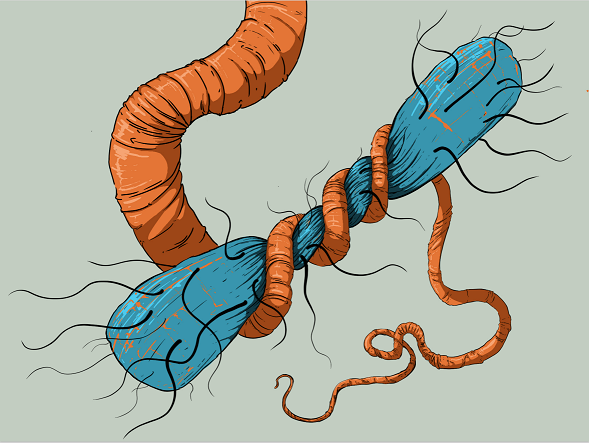Submitted by J. Hudson on Wed, 17/04/2024 - 13:41
Mr James Rooney, a BBSRC DTP student here at the Department of Veterinary Medicine (who recently passed his viva with flying colours! Congratulations James!), was first author on a recent publication that found that parasitic worms who live in the gastrointestinal tract of small ruminants release antimicrobial peptides (AMPs) that are able to inhibit growth of selected Gram+ bacteria in vitro. The research published in Computational and Structural Biotechnology Journal showed that parasitic worms who share their habitat with trillions of other microorganisms (the gut microbiome) may be able to modulate their microbial surroundings by actively producing and secreting AMPs that induce lysis of bacterial cells in their proximity.
The collaborative project was made up of a team of researchers from the UK and Denmark, and took two years to complete. Both first and senior author (Professor Cinzia Cantacessi) were from the Department of Veterinary Medicine, with other co-authors from the Department of Engineering, Department of Genetics, the Moredun Research Institute and the Technical University of Denmark in Copenhagen.
The study was conducted by undertaking in-depth bioinformatics analyses of proteomics datasets generated from secretions of key parasitic worms, and by applying predictive algorithms to the identification of putative AMPs. Subsequently, James travelled to Copenhagen where he worked with Dr. Esperanza de la Torre and her team, who are experts in the recombinant expression of complex proteins from eukaryotes, to produce two of the identified AMPs, a saposin and a metridin-like toxin, in vitro. Then, James undertook bacterial killing assays with the support of Dr. Ashraf Zarkan (Department of Genetics) and time-lapse microfluidics microscopy assays supported Associate Professor Somenath Bakshi and Mr Erez Li (Department of Engineering), and demonstrated that exposure of Bacillus subtilis to these recombinant AMPs resulted in cell lysis and significantly reduced growth rates.
James said, “We have known for a relatively long time that parasitic worms who live in the gut are able to shift the composition and function of the gut microbiota, possibly to create an environment that is more advantageous to them. This is the first study that identifies a possible mechanism through which worms may enact this. This was a complex project that involved a very diverse group of scientists with different and complementary expertise – it involved elements of parasitology, microbiology, bioinformatics, structural biology and engineering. I will always be grateful for the experience of working with so many talented scientists and the possibility of learning from each of them.”
Professor Cinzia Cantacessi, Senior Author on the study said “Our exciting paper shows how parasitic worms may interact with their ‘competitors’ in the vertebrate gut, and paves the way for future investigations aimed at deciphering the impact of such interactions on the pathophysiology of helminth infection and disease. Given the widespread problem of anthelmintic resistance, finding new ways to control parasites is a top priority, and achieving a better understanding of how parasites are able to live for so long in such a hostile environment – the vertebrate gut – may provide us with clues as to how to interfere with this extraordinary ability”.

